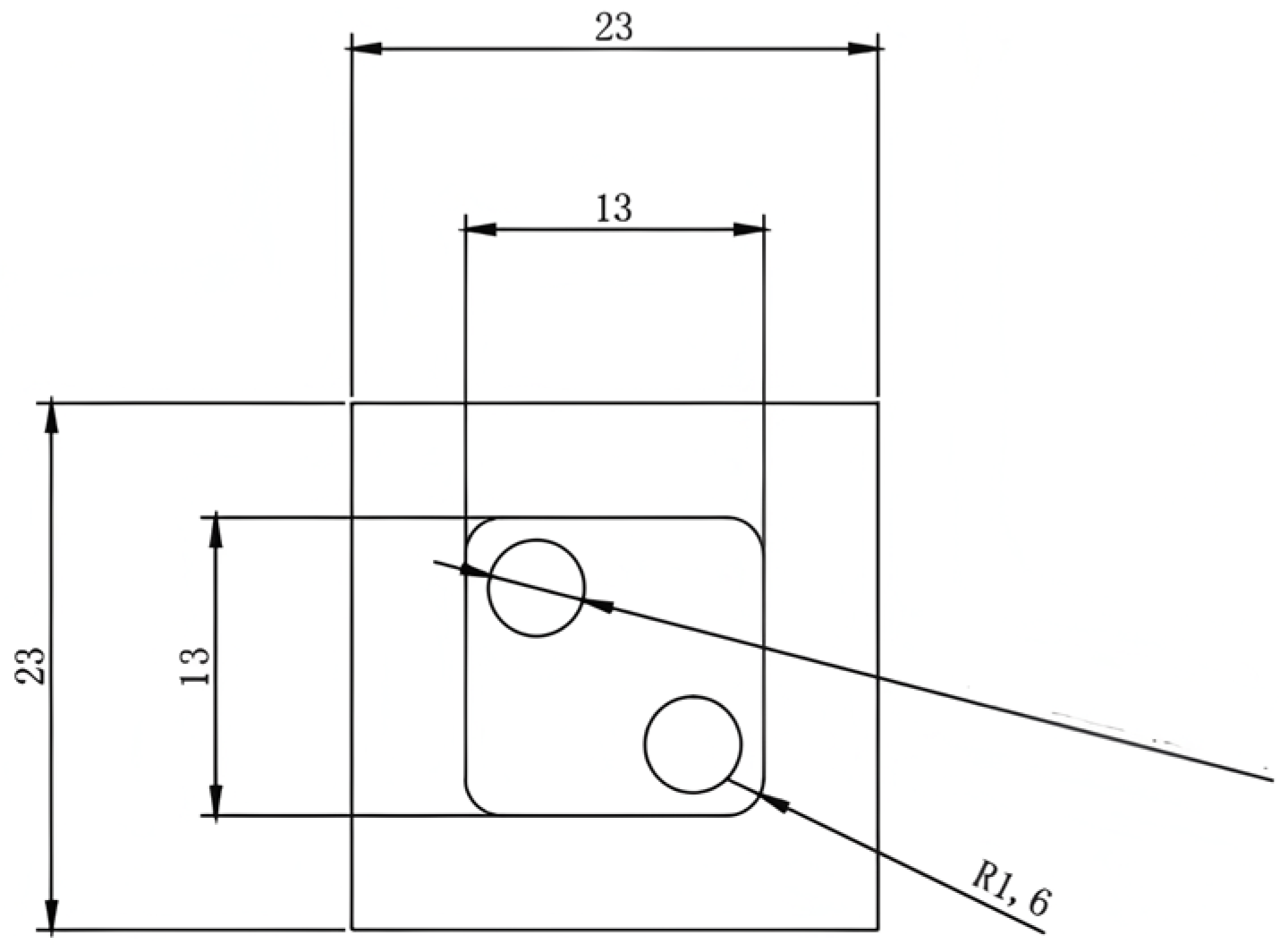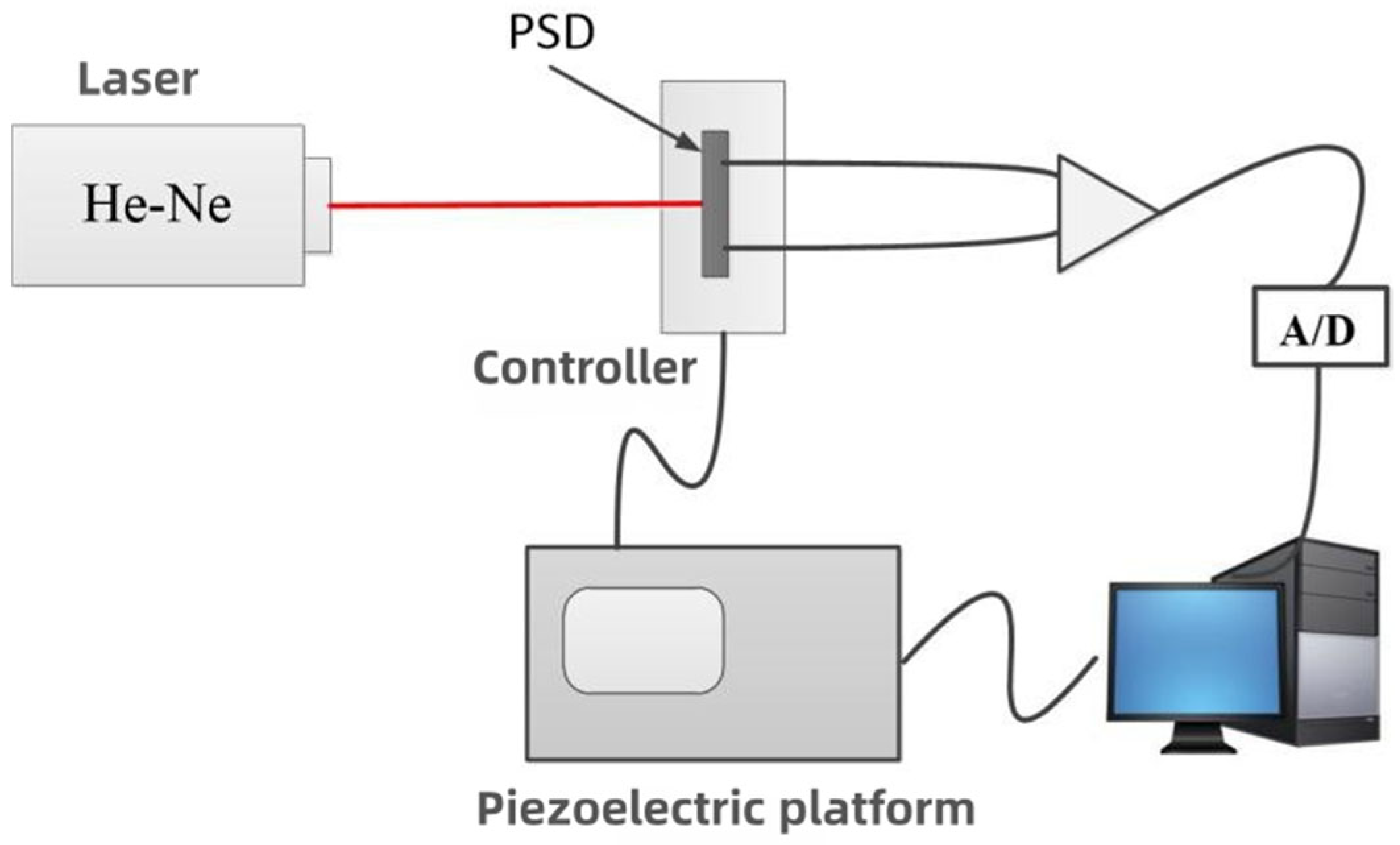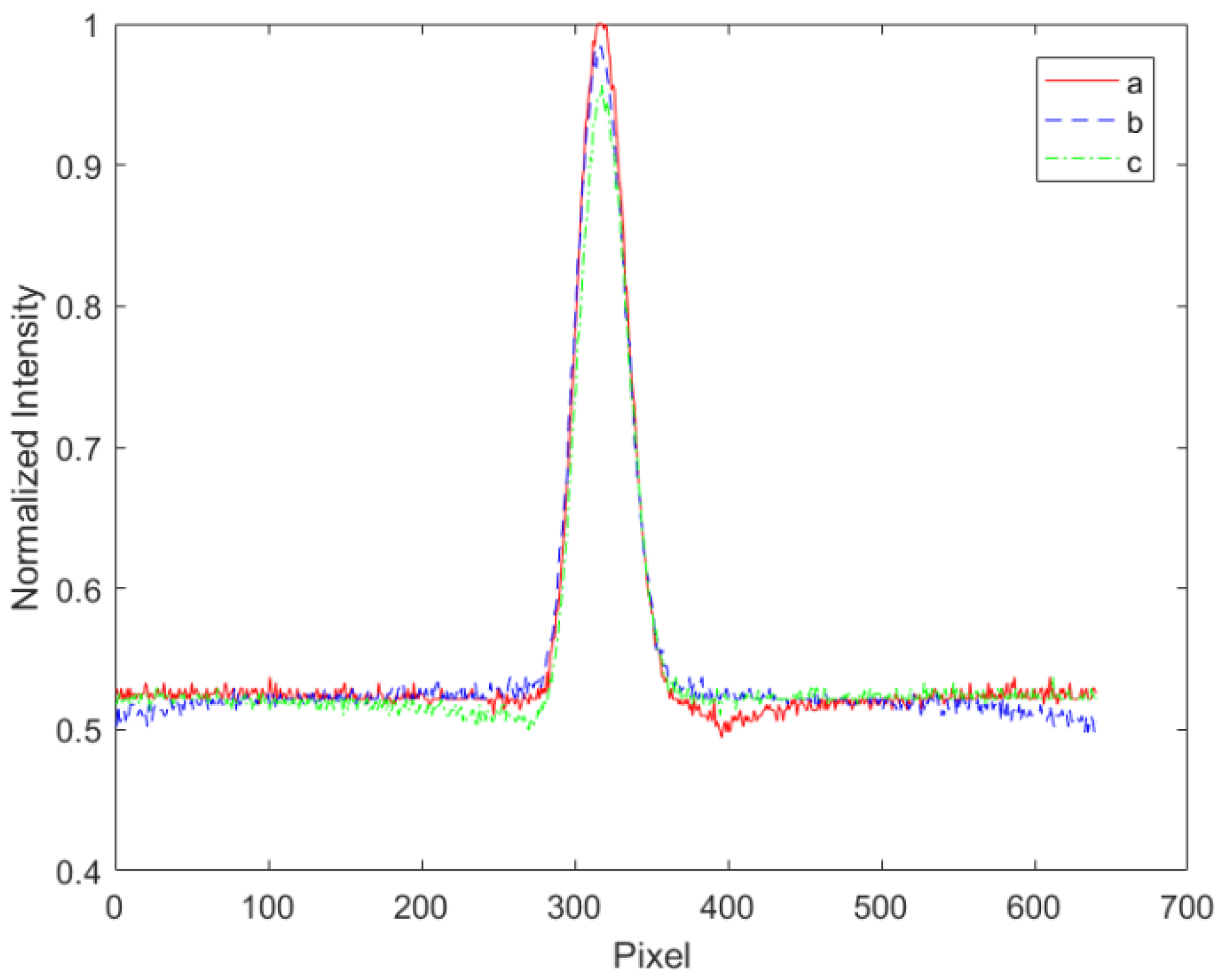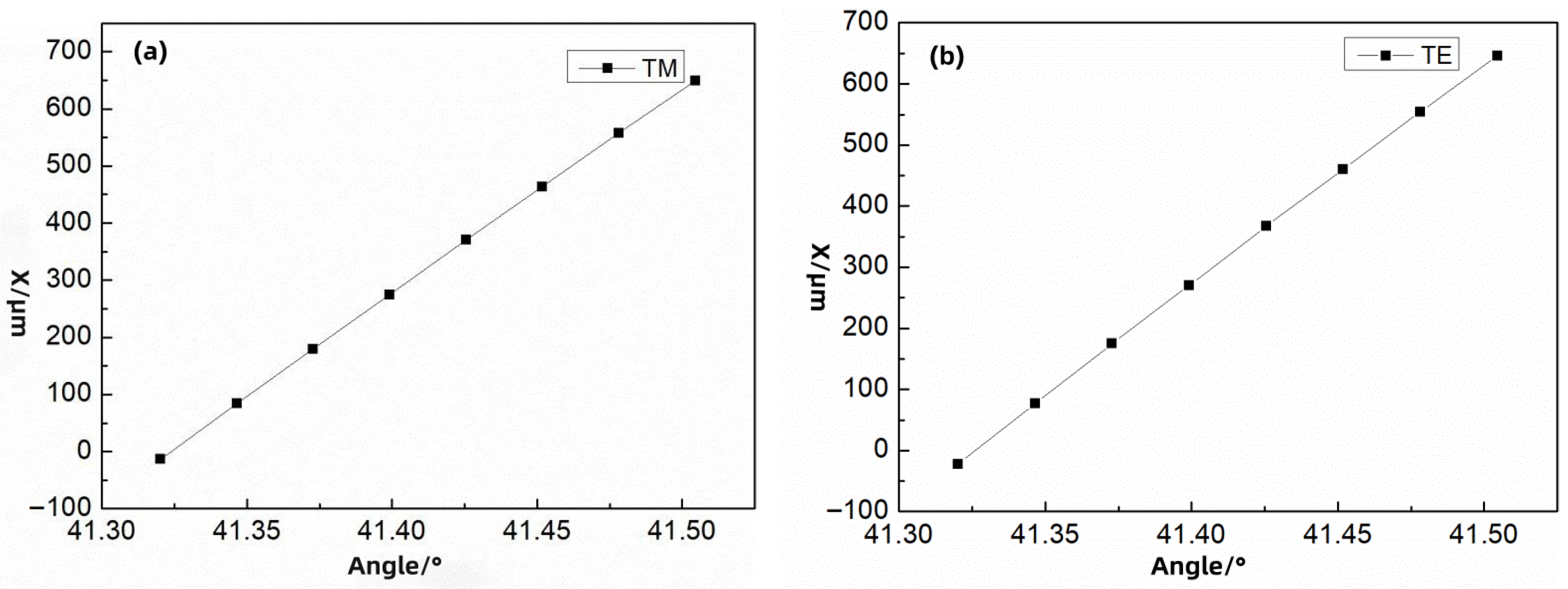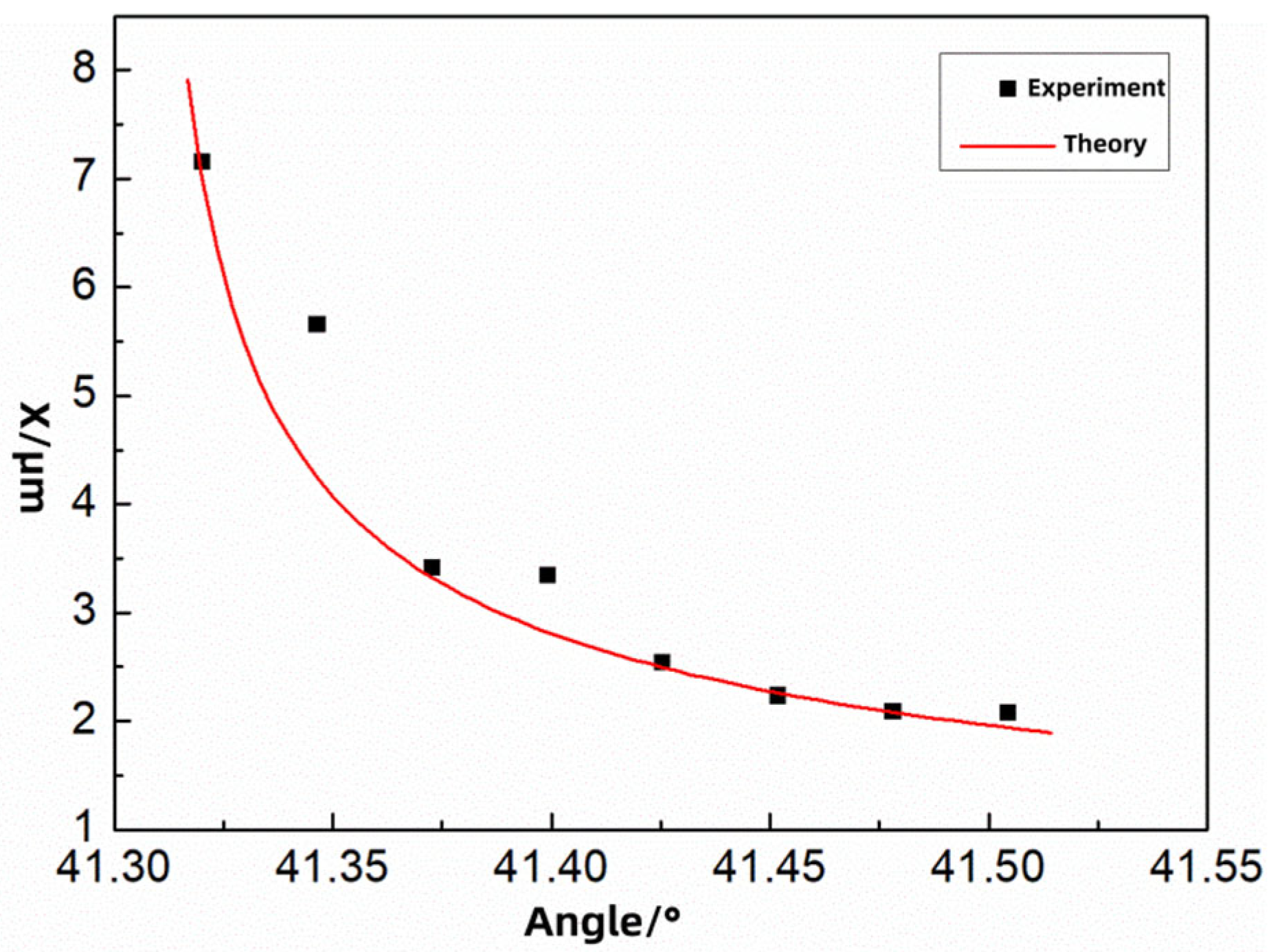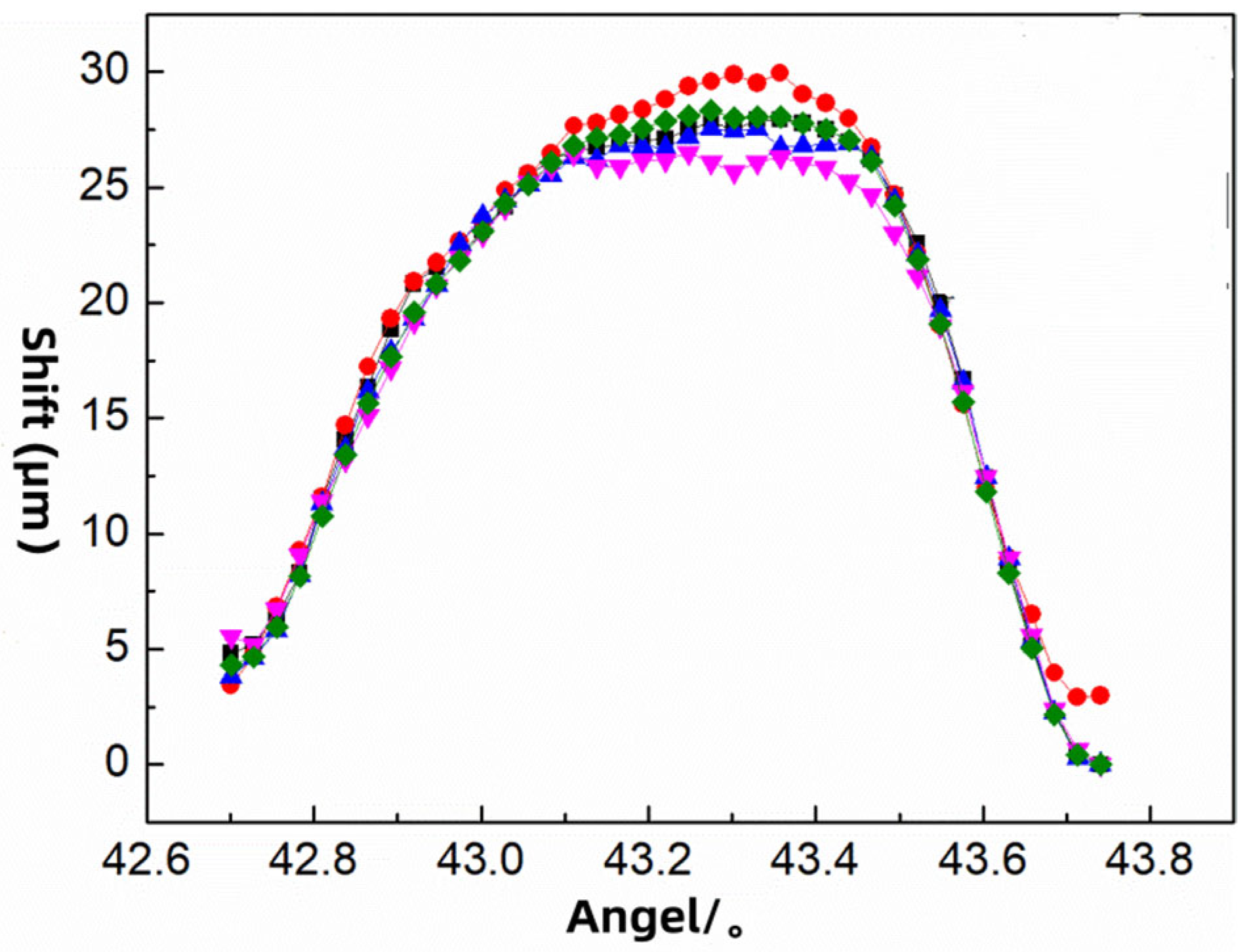1. Introduction
When a light beam undergoes total internal reflection at the interface of two media, the reflected beam is displaced slightly relative to the path predicted by geometrical optics [
1,
2,
3]. This small lateral displacement is known as the GH shift. In 1947, F. Goos and H. Hänchen were the first to observe this phenomenon experimentally. Since then, the GH shift, as a fundamental optical effect, has attracted extensive attention and has been gradually explored in other wave systems such as acoustics, quantum mechanics, and matter waves [
4,
5,
6,
7,
8]. For typical optical beams, the magnitude of the GH shift is extremely small (on the order of the wavelength of light), which makes its accurate measurement quite challenging [
9,
10]. Nevertheless, precise determination of the GH shift is scientifically important because it can be used to probe interfacial properties and to develop high-precision optical sensing techniques. In recent years, researchers have proposed various methods to observe and amplify the GH shift, including position sensitive detection [
11,
12], interferometric techniques [
13], and weak value amplification [
14,
15]. These approaches have significantly improved the sensitivity of GH shift measurements and have promoted the application of GH shift in precision metrology and sensing [
16]. At present, a large number of studies mainly focus on theoretical simulation, and experimental measurement of GH displacement is rarely reported.
A range of approaches have been explored for GH shift measurement, which can be broadly categorized into interferometric methods and direct spatial measurement methods [
17,
18]. Interferometric methods infer the GH shift indirectly by detecting phase changes or interference patterns associated with the reflected beam; however, such setups are often complex and highly sensitive to environmental perturbations. By contrast, direct measurement methods determine the GH shift by directly quantifying the lateral displacement of the reflected beam spot [
19]. While conceptually more straightforward, direct methods face the critical challenge of resolving extremely tiny spatial shifts. To enhance the detectability of the GH shift in direct measurements, a widely adopted technique is polarization differentiation-specifically, measuring the beam positions for transverse electric (TE) and transverse magnetic (TM) polarizations [
20,
21]. The TE/TM polarization difference method involves acquiring the centroid positions of the reflected beams for TE- and TM-polarized light, followed by calculating the difference between these positions. Under symmetric conditions, the GH shifts for TE and TM polarizations typically exhibit opposite signs or distinct magnitudes; this differential approach thus helps cancel out common systematic errors (e.g., mechanical drift) and doubles the effective signal, thereby improving measurement accuracy.
In this work, we present the design and implementation of a dedicated experimental system for GH shift measurement. The system comprises four modules: a light source module, an optical path module, a detection module, and a control module. Each module is carefully engineered to ensure high stability and accuracy. Leveraging this system, we perform GH shift measurements based on the TE/TM polarization difference method. We investigate the GH shift under various conditions (including different incident light wavelengths) and analyze the quality of the reflected beam spot to assess the influence of beam profile on measurement results. Experimental results demonstrate that the constructed system can reliably resolve micron-scale GH shifts. Notably, distinct differences are observed between the TE/TM difference method and direct measurement methods, while the variation trends of the GH shift with wavelength and interface refractive index are consistent across approaches. These findings not only validate the performance of the proposed measurement system but also provide a foundation for optimizing GH shift based sensors and facilitating further experimental research.
2. Experimental System Design
The GH shift measurement system constructed in this study comprises four functional modules: a light source module, an optical path module, a detection module, and a control module. The light source module provides a stable, coherent beam with adjustable polarization for GH shift experiments. Considering the requirements for monochromaticity and beam quality of the light source in GH shift measurement, three lasers were employed: a 450 nm semiconductor laser, a 532 nm semiconductor laser (Model MGL-III-532, Changchun New Industry Photoelectric Technology Co., Ltd., Changchun, China), and a 632.8 nm He-Ne laser (Model 1107P, JDS Uniphase Corporation, San Jose, CA, USA).
As illustrated in
Figure 1, the optical path module of the GH shift measurement device integrates three key functions: polarization modulation, incident angle control, and displacement generation. The workflow of the optical path is as follows: First, a parallel beam-after beam compression via a lens group passes through a primary polarizer, converting the beam into linearly polarized light (with the polarization direction forming a 45°angle with the horizontal plane). Subsequently, this linearly polarized light travels through a secondary adjustable polarizer; by rotating this polarizer, the beam’s polarization state can be modulated to either transverse electric (TE) or transverse magnetic (TM) polarization.
In this system, a prism serves as the displacement generator. The light beam enters the prism through one of its right-angle faces; total internal reflection occurs at the interface between the prism’s inclined surface and the sample contained in the flow cell, thereby generating the GH shift. The reflected light then exits the prism through its other right-angle face and irradiates the detector. To enable incident angle adjustment, the prism is fixed on a rotary stage; rotating the stage allows for variation in the beam’s incident angle at the point of total internal reflection.
All polarizers in the optical path are linear polarizers (Edmund Optics, Tucson, AZ, USA), each mounted on a rotatable optical mount. The polarization state of the incident light is adjusted by rotating these mounts. Prior to use, the transmission axis of each polarizer was calibrated using a polarization beam splitter prism (Model CCM1-PBS251/M, Thorlabs, Newton, NJ, USA).
By rotating the half-wave plate, we can align the polarization either parallel (TM) or perpendicular (TE) to the incidence plane with high extinction ratio, thus preparing the desired polarization state for each measurement. The output beam is spatially filtered and expanded if necessary to produce a clean Gaussian profile with sufficient beam width, because a finite beam width is required to observe the GH shift. This light source module delivers a consistent beam intensity and polarization, forming the foundation for accurate and repeatable GH shift measurements.
To ensure a well-defined beam spot at the reflection interface, we utilize a laser source characterized by high beam quality and low divergence. The laser output is inherently linearly polarized. To switch between TE and TM polarization states relative to the incident plane, a polarization controller—consisting of a polarizer and a half-wave plate—is integrated into the system. By rotating the half-wave plate, we can align the beam’s polarization either parallel (corresponding to TM polarization) or perpendicular (corresponding to TE polarization) to the incident plane, achieving a high extinction ratio. This allows precise preparation of the desired polarization state for each measurement. The laser output beam undergoes spatial filtering and, if necessary, beam expansion to generate a clean Gaussian profile with sufficient width. A finite beam width is essential for observing the GH shift, as the shift manifests as a lateral displacement of the beam’s spatial profile rather than a change in propagation direction. Through these optimizations, the light source module delivers a stable beam intensity and consistent polarization state, laying a robust foundation for accurate and repeatable GH shift measurements.
When total internal reflection occurs, the evanescent wave generated exists only in a very thin layer (approximately one wavelength thick) of the optically rarer medium. Therefore, when studying the GH shift at the prism–liquid sample interface, only a tiny amount of sample is required. For this purpose, we designed a flow cell suitable for GH shift detection of small volume samples, whose cross section is shown in
Figure 2. The flow cell has a volume of 13 × 13 × 6 mm
3, with a sample inlet and a sample outlet provided at the bottom. The designed flow cell was commissioned to Suzhou Wenhao Chip Technology Co., Ltd. (Suzhou, China). for manufacturing. The flow cell is made of polymethyl methacrylate (PMMA). Polyether ether ketone (PEEK) fittings are installed at the sample inlet and outlet at the bottom of the cell, respectively, and connected to polytetrafluoroethylene (PTFE) tubes. The upper part of the flow cell is bonded to the inclined surface of the triangular prism using PMMA tape, thereby forming a closed space. When the solution in the flow cell is above the position of the light spot, a prism–sample interface is formed, allowing the measurement of the sample’s GHS. The use of the flow cell not only reduces the amount of sample to be tested but also makes the replacement of samples very convenient.
In the actual experimental operation of this study, we have controlled the residue on the prism surface through a set of standardized cleaning procedures. We now supplement the details as follows: (1) Preliminary rinsing: After removing the previous liquid, the contact surface between the flow cell and the prism is first rinsed continuously with ultrapure water (resistivity ≥ 18.2 MΩ·cm) at a flow rate of 1.5 mL/min for 3 min. The high purity of ultrapure water is used to reduce impurity residues. (2) Reagent-assisted cleaning: If the previous liquid is a high-viscosity or easily adsorbable system (e.g., polymer solutions with a concentration > 5%), additional rinsing with absolute ethanol (analytical grade) is performed for 1 min to remove stubborn residues using the solubility of ethanol. Subsequently, ultrapure water is used again to rinse for 2 min to eliminate ethanol residues. (3) Drying verification: After rinsing, clean nitrogen gas (purity 99.999%) is introduced to blow dry the prism surface at a flow rate of 0.8 L/min until no water stains or liquid traces are observed on the surface via an optical microscope, ensuring no liquid residues affect subsequent refractive index measurements.
To further verify the cleaning effect, we also implement quality control through a blank control experiment: after each sample replacement, the reflected light signal of ultrapure water on the prism surface is first measured (the refractive index of ultrapure water is a known fixed value of 1.3330). If the deviation between the refractive index measurement corresponding to this signal and the standard value is ≤0.0005, the prism surface is judged to be free of residues, and subsequent sample measurements can be conducted; if the deviation exceeds the range, the above cleaning process is repeated until the requirement is met. This verification step effectively avoids the interference of residual previous liquid on the measurement results of samples with different refractive indices.
The magnitude of the GH shift is on the order of the light wavelength, rendering it challenging to observe and utilize in experimental contexts. In the early stages of research, GH shift measurements primarily relied on either the multiple total reflection method or the use of longer wavelength microwaves (a choice that simplified detection due to their larger inherent scale). With the advancement of detection technologies, a variety of detectors have been gradually applied to GH shift measurement, significantly enhancing the accuracy of displacement detection.
Compared with other position-sensing devices (e.g., charge-coupled devices (CCDs), quadrant detectors, and photodiode arrays), position sensitive detectors (PSDs) offer distinct advantages: they enable continuous detection of the light spot position, exhibit high resolution and fast response speeds, require simple circuitry, and remain unaffected by the shape or intensity of the incident light. In recent years, PSDs have thus been widely adopted for GH shift measurements under single total reflection conditions.
In the aforementioned light source module, three visible light sources with wavelengths of 450 nm, 532 nm, and 632.8 nm were selected. Given that the GH shifts to be measured are on the wavelength order, a PSD with high resolution is essential. Generally, the resolution of a PSD is inversely proportional to its physical size. Considering the dual requirements of resolution and sensitive area for GH shift measurement, we chose the PSM 2–4 PSD (On-Trak Photonics, Irvine, CA, USA) as the detection device. This PSD features a resolution of 100 nm and a sensitive area of 4 × 4 mm, which fully meets the demands of GH shift measurement in this experiment.
In addition to the PSD, the detection module includes an OT-301 position sensor amplifier and an OT-302D display device On-Trak Photonics, Irvine, CA, USA). The OT-301 amplifier is used to amplify and process the current signal output by the PSD; it offers six gain settings and accommodates an input current range of 0.1 μA to 1.5 mA (Note: “0.1 A” was corrected to “0.1 μA” to align with typical PSD output current magnitudes, as 0.1 A is physically unrealistic for such devices). The amplified position signal undergoes analog-to-digital (A/D) conversion via the OT-302D display device before being visualized. This display device can also be paired with supporting software to enable real-time display and recording of the light beam’s position information on a computer.
The control module leverages a computer to regulate three key functions: the rotation of the electric rotary stage, data acquisition from the PSD, and modulation of the beam’s polarization. Adjusting the incident angle of the light beam is achieved by rotating the rotary stage; however, the rotation angle of the stage does not directly correspond to the change in the beam’s incident angle, as illustrated in
Figure 3Assuming the center of the prism’s inclined edge coincides with the center (O) of the rotary stage, letαdenote the rotation angle of the stage and θ denote the corresponding incident angle of the beam at the prism’s inclined surface. The relationship between α and θ is discussed under two scenarios:
(a) When α = 0°, the light beam is incident perpendicularly on the prism’s right-angle edge, resulting in θ = 45°.
(b) When the stage rotates clockwise byα°, the light beam strikes the prism at an initial angle, and subsequent reflection at the prism’s inclined surface leads to a change in θ. The specific value of θ in this case is derived through geometric analysis (details omitted for brevity). To eliminate the influence of backlash (return stroke difference), the stage is rotated in a consistent direction throughout measurements. From the above analysis, the relationship between the stage’s rotation angle (α) and the beam’s incident angle (θ) can be established—enabling precise adjustment of θ to the desired value via computer control.
The system employs the ZX110-100 precision electric rotary stage (Beijing Lianying Precision Machinery Technology Co., Ltd., Beijing, China). This stage utilizes a worm gear mechanism, offering a resolution of 0.01° (without subdivision) or 0.0005° (equivalent to 1.8 arcseconds) when configured with 20-fold subdivision. Through its software control interface, parameters such as rotation angle, speed, and time interval are programmed to achieve accurate, timed control of the incident angle. For the OT-302D display device, its dedicated software allows setting of the data acquisition start time, the time interval between consecutive data points, and the total acquisition duration. Automatic measurement of the reflected light’s position is realized through the coordinated configuration of the rotary stage control software (SF V3.3) and the OT-302D software (OT V2.0).
Based on the above analysis, a complete GH shift measurement system was constructed, as shown in
Figure 3. The laser output from a He-Ne laser (Model 1107P, JDSU, San Jose, CA, USA) is collimated and reduced in beam size via a lens group to form a parallel beam with a spot diameter of 1 mm. This beam then passes through a first polarizer (Model #43-787, Edmund Optics, Tucson, AZ, USA), which adjusts it to linearly polarized light with a polarization angle of 45°.
Next, a second polarizer is rotated to modify the incident light’s polarization direction: when the polarizer’s transmission axis is aligned horizontally (0°), transverse magnetic (TM) polarized light is obtained; when aligned vertically (90°), transverse electric (TE) polarized light is generated. The polarized light is then incident on an isosceles right-angle prism (Model PS911, Thorlabs, Newton, NJ, USA) and reflected at the prism’s inclined surface.
The position signal of the reflected light, detected by the PSM 2–4 PSD, is amplified by the OT-301 amplifier (On-Trak Photonics, Irvine, CA, USA). Following A/D conversion via the OT-302D display device, the signal is transmitted to a computer for subsequent data processing.
Once the raw data are collected from the detection module, we process them to extract the GH shift values. The primary data consist of the measured centroid positions of the reflected beam spot under various conditions (different polarizations, angles, etc.). To convert these raw positions into a GH shift, we define a reference position corresponding to zero shift. One convenient reference is the position of the reflected beam when the incidence angle is sufficiently far from the critical angle (where the GH effect is negligible and the reflection follows geometric optics closely). Alternatively, a baseline can be established by aligning the system so that, at a certain configuration, the expected GH shift is zero (for instance, using a slight adjustment or calibration target). The difference between the observed beam position at a given condition and this reference position is calculated as the GH lateral displacement. For the TE/TM polarization difference method, we take the centroid for TE and TM at the same incidence angle and computeΔx = xTM-xTE (or vice versa), representing the differential lateral shift. If TE and TM shifts are equal in magnitude and opposite in direction relative to the geometric reflection point, this difference is approximately twice the magnitude of each individual GH shift.
3. System Testing and Experimental Verification
To ensure the PSD can accurately measure wavelength-scale displacements in practical experiments, we conducted a performance test on the PSD. The test optical setup is illustrated in
Figure 4, with the following configuration:
A He-Ne laser (Model 1107P, JDSU, San Jose, CA, USA) emits a beam that irradiates the PSM 2-4 PSD detector. The position signal acquired by the PSD is first amplified and subjected to analog-to-digital (A/D) conversion, then transmitted to a computer for real-time display. The PSD itself is fixed on a piezoelectric translation stage (Model P-611.3S, Physik Instrumente GmbH & Co. KG, Karlsruhe, Germany). By adjusting the translation stage’s movement, the relative position of the PSD with respect to the incident laser beam can be precisely altered—an operation equivalent to changing the beam’s impingement position on the PSD’s photosensitive surface.
The PSD’s performance was evaluated by comparing the actual displacement of the piezoelectric stage (a known reference value) with the beam displacement measured by the PSD. The test results are presented in
Table 1. As shown, the relative error between the piezoelectric stage’s displacement and the measured beam displacement is controlled within 3%. This confirms that the PSD exhibits high reliability for use in displacement measurement tasks, meeting the precision requirements of wavelength scale GH shift detection.
When a light beam reflects at an interface, the intensity distribution of the reflected light may change; moreover, different incident angles can lead to variations in the beam spot. To investigate whether the spot shape changes under different conditions, we analyzed the reflected beam spots across a range of incident angles.
Specifically, a CCD camera was used to capture the reflected beam spots when 532 nm TE-polarized and TM-polarized light were incident on the interface. The spot images were then processed using MATLAB R2023A to extract their light intensity distributions, with the results shown in
Figure 5. The curves in the figure represent the light intensity profiles along a horizontal line passing through the center of each spot. During image processing, the intensity distribution of each spot was translated to align the contours of all images—this alignment facilitated clearer observation of potential changes in spot shape. As illustrated in
Figure 5, the energy of the reflected beam remains concentrated at the center of the spot across all tested incident angles, with no significant distortion of the spot shape observed.
Using the aforementioned GH shift measurement device, we measured the positional distribution of reflected light at the prism–air interface under different incident angles, with TM-polarized light and TE-polarized light incident separately. The results are presented in
Figure 6. As observed from this figure, the light spot shifts along the positive X-axis direction of the detector as the incident angle increases. In the experimental measurements, the distance between the TM-polarized light and TE-polarized light (under non-total reflection conditions) was determined to be 1.3 μm.
To obtain the relative GH positional values at the prism–air interface (as shown in
Figure 6), we calculated the difference between the beam positions in
Figure 7 and subtracted the correction value. The refractive indices of the prism and air are 1.515 and 1, respectively; through calculation, the critical angle for total reflection was found to be 41.30°. To minimize experimental errors, we collected multiple sets of data, calculated their average, and made every effort to ensure the beam was as perpendicular as possible to the photosensitive surface of the PSD.
Near the critical angle of total reflection, a maximum displacement of 2 μm was measured, which is approximately 11.3 times the wavelength of the incident light. As the incident angle further increased, the displacement decreased rapidly before stabilizing at 2 μm. It can be concluded that the theoretical and experimental results are in good agreement. Furthermore, the measurement results of this experiment are consistent with both the trend and order of magnitude of GH displacement reported in Reference [
13], which further validates the reliability of the experimental device constructed in this study.
To avoid randomness and contingency in the experimental results, we conducted extensive stability and repeatability tests. Below, an illustration is provided using the position information of reflected light obtained when a 532 nm light is incident on the prism–silver nanoparticle film interface. In this case, the enhancement effect of displacement is relatively weak, which can better reflect the influence of various factors on the results. For the beam position at each incident angle, one data point was collected every 2 s, and a total of 120 data points were recorded. During the recording process, the detected beam position was not constant; instead, it fluctuated back and forth, as shown in
Figure 8. Calculations show that in the X-direction, the mean value of the data is 21.74 m with a standard deviation of 0.13; in the Y-direction, the mean value of the data is 127.83 m with a standard deviation of 0.32. It can be seen that the data are relatively stable, and the impact of their fluctuations on the measurement of the Goos–Hänchen (GH) displacement is negligible. In the data processing, the average value of the data was used for calculation.

